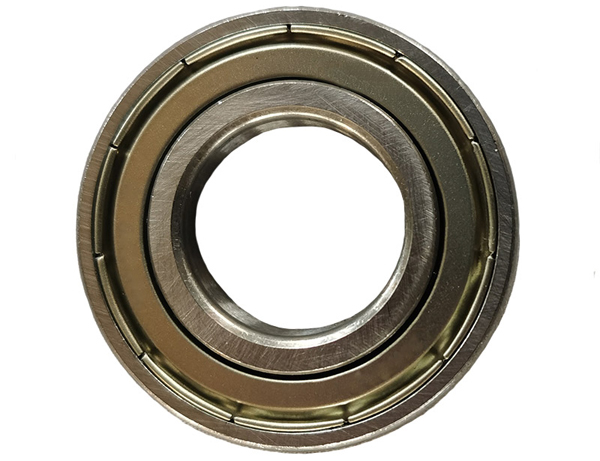Deep groove ball bearing
Deep Groove Ball Bearing is a common type of bearings and it is used in several industries from heavy machinery to high precision apparatus. This type of bearings consists of four elements that include inner ring, outer ring, cage that holds balls and ball bearings. Because of the flat surface on outer ring and inner ring, Deep Groove Ball Bearings provides a larger area of contact that delivers high performance and high load capacity. Although Deep Groove Ball Bearings come in hundreds of models and sizes with different design and even different material used in inner ring, outer ring and the cage but basically they are categorized in 4 main sections.

TYPES OF DEEP GROOVE BALL BEARINGS
Based on different designs, structures and ultimately applications, there are mainly 4 types of Deep Groove Ball Bearings. Let’s see what these deep groove ball bearings do and what the core difference between them is.
● Single Row Deep Groove Ball Bearings
In this particular type of Deep Groove Ball Bearings, the cage is made of pressed steel that gives it high load capacity and flexibility at the same time. This is one of the most widely used types of Deep Groove Ball Bearings. This type of bearings is either made with open bearings or they might have steel or rubber shields depending on the requirements of the apparatus. Other materials instead of pressed steel are also used to make the cage.
● Extra Small Bearings and Miniature Ball Bearings
As the name suggests, in this type of ball bearings small balls are used as rolling elements and basically we can divide them into two categories that are deep groove and angular contact. Deep Groove Miniature Ball Bearings are further divided into five subcategories that are standard type, flanged outer ring, expanded one ring, thin section and extended inner ring.
● Maximum Type Ball Bearings
This type of ball bearings come with a significantly larger number of ball bearings as compared to other type of Deep Groove Ball Bearings and because of high number of ball bearings used in them, this particular type of Deep Groove Ball Bearings delivers high precision and high performance. This type of bearings could be open or shielded depending on the application and requirements. The cages in this type of Deep Groove Ball Bearings are made of pressed steel to deliver high performance and load capacity.
● Magneto Deep Groove Ball Bearings
The inner ring of this type of bearings is a little deeper than other types and because of only one shoulder on outer ring, it can be removed for maintenance or mounting. This type of Deep Groove Ball Bearings are well known for delivering high precision and they come in smaller sizes as compared to other types. Some of the main applications of this type of ball bearings are gyroscopes.
Angular contact ball bearing
The term angular contact ball bearings is a term used for special ball bearings. Analogue to radial deep groove ball bearings, the balls are guided through deep grooves in the inner and outer race with a narrow bevelling plane. Again, the relatively small areas of contact between the balls and the raceway (point-contact) make the rolling resistance very small. The so-called cage prevents the balls touching and thus permits low-friction load transmission of moving machine parts.
The difference between these and deep groove ball bearings is that the bearing cross-section is designed asymmetrically. Angular contact ball bearings are designed to support loads whose line of application is not perpendicular to the bearing axis but rather at a certain angle to the perpendicular axis (contact angle). For this purpose, the shoulder is designed more pronounced around the ball (contact zone) near the line of application (contact angle), allowing loads applied at an angle to be supported better. If angular loads are split up into their radial and axial load shares, angular contact ball bearings can only support axial loads in one direction on account of their design.
The opposite bearing shoulder is much less pronounced to make mounting easier. Care must be taken to install the bearing the right way round.
Contact angles of 15°, 25° and 40° are common. The larger the contact angle, the higher the axial load capacity. At the same time, the maximum speed limit is reduced as the contact angle increases.
In practice, angular contact ball bearings are often used in pairs. This allows axial loads to be supported in both directions. Depending on the pattern of load application lines, specialists talk about O or X layouts. If two bearings are mounted behind one another with identical contact angle alignment, the term tandem layout is used.
Modern angular contact ball bearings are usually filled with suitable roller bearing grease and thus maintenance-free for many applications. Sealing and oil supply expenditure are no longer required. However, no heat is dissipated from inside the bearing when grease is used as a lubricant.
Depending on the number of ball rows used, a distinction is made between single-row and multi-row angular contact ball bearings.
In addition, angular contact ball bearings are categorised according to the quality of raceway and manufacturing tolerances into angular contact ball bearings (normal version) and spindle bearings (high-precision version).
Four-point contact ball bearings have been developed to support axial loads in both directions.
In these cases, either the outer race (Q-series) or the inner race (QJ series) is divided.
We offer various Deep Groove Ball Bearings. Contact us for a quote!
评论
发表评论